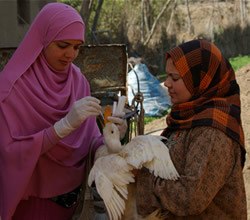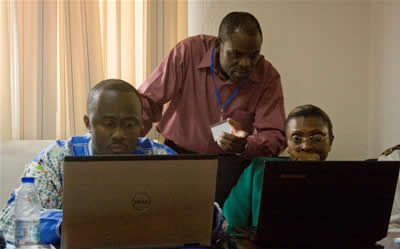
Building the Capacity to Control Animal-Borne Influenza in Cameroon and Egypt
This year, CTR researchers Dr. Trevon Fuller, Dr. Ryan Harrigan, and Dr. Kevin Njabo trained government scientists and academics in Egypt and Cameroon in techniques to predict and detect influenza outbreaks in wildlife and domestic animals. The ultimate goal of the workshops was to improve the capacity of local governments to predict and prevent future epidemics. These workshops grew out of CTR’s participation in the Zoonotic Influenza Collaborative Network funded by the Fogarty International Center at the National Institutes of Health. At the first workshop, held in Cairo in February, CTR engaged Egyptian scientists from governmental agencies including the General Organization for Veterinary Services (GOVS), the National Laboratory for Quality Control of Poultry Production (NLQP), the Animal Health Research Institute (AHRI), and expert faculty at Damietta University. One of the most significant health risks in Egypt is the highly pathogenic H5N1 avian influenza virus. Since 2006, this virus has killed millions of birds in Egypt. Furthermore, the virus has jumped the species barrier to infect humans, resulting in 168 cases with a 36% fatality rate.

The Cameroon workshop, held in August, was attended by scientists from local government institutions including the Ministry of Livestock, Fisheries and Animal Industries (MINEPIA), the Ministry of Scientific Research and Innovation (MINRESI), the University of Yaoundé I, and the Centre Pasteur of Cameroon (CPC). Although Cameroon has had fewer cases of H5N1 than Egypt, another type of flu, H1N1 swine flu, is an important pathogen in Cameroon’s domestic animals, and CTR recently published an article on the first evidence of H1N1 in pigs in Cameroon (View paper). The H1N1 virus is a perennial public health issue. A salient example is the 2009 the pandemic influenza virus, which was given the official name “H1N1 swine-origin influenza”, but was popularly known as “swine flu”. We know for sure that swine flu killed 20,000 people worldwide according to laboratory tests. However, based on statistical models that extrapolate from lab-confirmed deaths, it is likely the virus killed a total of 280,000 people, primarily in Africa and Asia. Furthermore, swine flu contained genes from influenza strains that normally infect birds and swine, so understanding the circulation of the influenza virus in animals is critical to preventing future influenza pandemics in humans.

The curricula of both workshops included:
(1) Presenting the technical tools necessary to develop a predictive ecological model to identify at-risk areas for avian influenza in Egypt and swine influenza in Cameroon and surrounding regions. Such tools use geo-referenced locations of influenza cases and models risk based on their association with bioclimatic and satellite remote sensing data.
(2) Producing models that compare transmission dynamics across countries/governorates and predicting transmission risks to humans. These comparisons can then be used to address whether different animal husbandry and/or cultural practices increase the risk of influenza in particular areas.
(3) Formulating a strategy for bringing expertise, resources, and logistics to increase the capacity of Cameroonians and Egyptians to produce their own risk assessment maps in the future so that government ministries approve, guide, and receive the benefits of these research efforts.
(4) Disseminating the results of spatial models to decision-makers and producing manuscripts from this work that can inform a broader scientific audience.
We are optimistic that teaching these state-of-the-art techniques for disease detection and prevention to our Cameroonian and Egyptian colleagues will help these countries combat avian flu and swine flu more effectively in the future.
